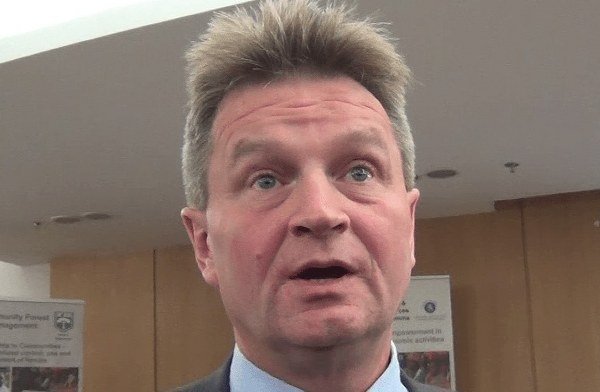The European Union has launched three projects under the EU 11th EDF Cross-Regional Wildlife Conservation programme in Eastern and Southern Africa and the Indian Ocean to protect and promote the country’s marvellous biodiversity endowment.
Speaking at the launch, Ambassador Timo Olkkonen, the Head of EU Delegation to Zimbabwe said this country’s natural riches are not only something for its citizens to cherish, but they form part of a world heritage.
Ambassador Olkkonen alluded to the UN Intergovernmental Science-Policy Platform on Biodiversity and Ecosystem Services assessment report, in which researchers report that 1 million species are threatened with extinction, global biodiversity is declining at unprecedented speed, and that 75 percent of Earth’s land surface has been significantly altered.
“Indeed, according to the assessment, pressure from human population growth is creating more demand for energy and resources. In the words of Dr Robert Watson, chair of the Intergovernmental panel, “We are eroding the very foundations of our economies, livelihoods, food security, health and quality of life worldwide”
“Human activities are actually undermining the foundations of the Sustainable Development Goals pyramid, a descriptive architecture of the SDG in which Life on Land, Life Below Water, Climate Action and Clean Water, the so-called Biosphere goals sustain the remaining Social and Economic goals. Something has to be done, so what is the EU doing in this context? We are putting a lot of effort in promoting a culture of sustainable development with particular focus on climate and environment action at every level, be it global, regional, national and local,” Ambassador Olkkonen said.
The EU has had a leading role in the global efforts to tackle climate change, and the recent European Parliament elections testified that Europeans want further serious action in this field. The EU is also tackling biodiversity degradation, especially wildlife conservation.
At global level the European Commission launched in November 2015 the study “Larger than Elephants: Inputs for an EU Strategic Approach to Wildlife Conservation in Africa” as part of the EU’s flagship initiative Biodiversity for Life which promotes coherence and coordination of EU actions in the area of biodiversity and ecosystems
The Larger than Elephants approach addresses the illegal trade in wildlife and reviews strategies for stopping the killing, the trafficking and the demand for wildlife products.
He said in order to exploit economies of scale, hence enhance wildlife conservation efficiency, Africa needs to focus on regional conservation strategies. Among the most effective policies in this regard, Ambassador Olkkonen cited the Transfrontier Conservation Areas, a well-developed model embraced by SADC, through signed Protocols on Forestry, Fisheries and Wildlife Conservation and Law Enforcement among bordering countries, which promotes transboundary collaboration in the management of the shared biodiversity, including ecosystems, river basins, and watersheds.
“Another EU policy worthwhile to mention is the EU Action Plan against Wildlife Trafficking, adopted in 2016, which spells out priority activities to halt the impact of wildlife crime on ecosystems and on economies affected directly or indirectly by the increase in wildlife crime. I want to assure you that these two global EU policies in the wildlife sector are supported by a significant amount of funding.”
The EU has taken action to support biodiversity conservation, both within its boundaries and internationally, with the commitment of more than €500 million in Africa over the past 30 years.
Ambassador Olkkonen said the current portfolio of on-going projects amounts to approximately €160 million and during 2014-2020, it has invested €710 million in wildlife conservation across Africa. Under this envelope an allocation of €30 million is earmarked for a Cross-Regional Wildlife Conservation (CRWC) programme in Eastern and Southern Africa and the Indian Ocean.
]The 3 projects launched and explore are part of the Cross-Regional Wildlife Conservation (CRWC). Elements of Trans-frontier Conservation Areas establishment and operation extend from the highest level down to the grassroots at Community level, the keystone for the success of any conservation program
“Communities are in fact the core beneficiaries of these projects as we believe they play a critical role in the sustainable management of natural resources. From our own experience on the ground, supported by a number of reputable studies and research, we can realistically state that communities are our first line of defence against poaching, human wildlife conflict, illegal wildlife trafficking and land degradation.
“We are not reinventing the wheel, we are actually reinforcing what this country audaciously conceived in the ’80 with the CAMPFIRE program. I also have to say that Communities’ critical role in wildlife conservation was vocally expressed by all participating Heads of State at the recent Wildlife Economy Summit in Victoria Falls. Hence, the objective of these 3 projects is common: to enhance community based cross-border cooperation on natural resources management, with a particular attention to wildlife conservation in terms of anti-poaching and human wildlife conflict and illegal wildlife trafficking mitigation.”
Ambassador Olkkonen emphasised the need to give communities a voice in the decision making process and an incentive to support wildlife conservation as an economically viable and competitive land use option. He said the 3 projects represent an effort to specifically empower communities voice their minds, actively participate in the decision making process and build the necessary technical and business management capacity to enable them generate viable and sustainable livelihoods.






